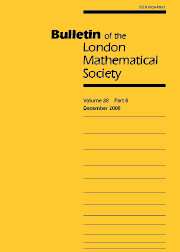No CrossRef data available.
EVALUATION OF SUPERHARMONIC FUNCTIONS USING LIMITS ALONG LINES
Published online by Cambridge University Press: 01 March 2000
Abstract
If u is a superharmonic function on ℝ2, then
formula here
for all (x, y) ∈ ℝ2. This follows from the fact that a line segment in ℝ2 is non-thin at each of its constituent points. (See Doob [1, 1.XI] or Helms [7, Chapter 10] for an account of thin sets and the fine topology.) The situation is different in higher dimensions. For example, if u is the Newtonian potential on ℝ3 defined by
formula here
then
formula here
Corollary 2 below will show that, nevertheless, for nearly every vertical line L, the value of a superharmonic function at any point X of L is determined by its lower limit along L at X.
Throughout this paper, we let n [ges ] 3. A typical point of ℝn will be denoted by X or (X′, x), where X′ ∈ ℝn−1 and x ∈ ℝ. Given any function f[ratio ]ℝn → [−∞, +∞] and any point X, we define the vertical cluster set of f at X by
formula here
and the fine cluster set of f at X by
formula here
Information
- Type
- NOTES AND PAPERS
- Information
- Copyright
- © The London Mathematical Society 2000

